Thecus N2560: Intel's EvanSport NAS Platform Review
by Ganesh T S on November 25, 2013 3:30 PM ESTCIFS Performance Evaluation
Evaluating the N2560 was fairly straightforward. We only needed to check up on CIFS performance (as both NFS and iSCSI are not supported). The unit was configured with two WD4000FYYZ (WD RE) 4 TB drives in RAID-1 configuration. From the outside, it looks like it would be ideal to compare the performance of this unit with that of the ReadyNAS 312 we reviewed a couple of weeks back. Unfortunately, the presence of two GbE ports on the RN312, as well as business targeted feature set puts it in a different class. As such, we can compare with other ARM-based 2-bay units. The Synology DS213 is one such unit that we have evaluated before in the form of the ioSafe N2.
Single Client (Windows) Mode:
The single client CIFS performance of the Thecus N2560 was evaluated on the Windows platforms using Intel NASPT and our standard robocopy benchmark. This was run from one of the virtual machines in our NAS testbed. All data for the robocopy benchmark on the client side was put in a RAM disk (created using OSFMount) to ensure that the client's storage system shortcomings wouldn't affect the benchmark results
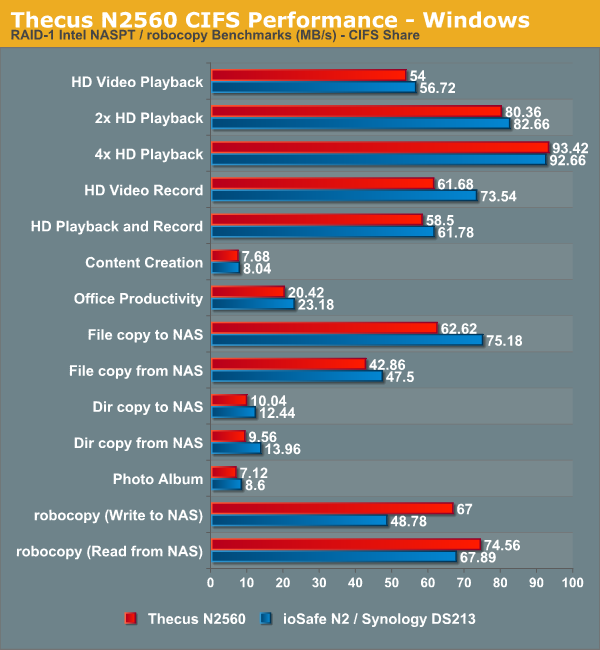
We find that the ARM-based ioSafe N2 / Synology DS213 performs better than the Thecus N2560 in a majority of the tests. However, the robocopy benchmarks (more representative of home users copying lots of files to and from the NAS) land in favour of the Thecus N2560. I would say that, based on performance alone, the Thecus N2560 will run neck-and-neck with the modern ARM-baed 2-bay units such as the Synology DS213.
Multi-Client (Windows) Mode:
We put the Thecus N2560 through some IOMeter tests with a CIFS share being accessed from up to 25 VMs simultaneously. The following four graphs show the total available bandwidth and the average response time while being subject to different types of workloads through IOMeter. IOMeter also reports various other metrics of interest such as maximum response time, read and write IOPS, separate read and write bandwidth figures etc.. Readers interested in the actual values can refer to our evaluation metrics table available here.
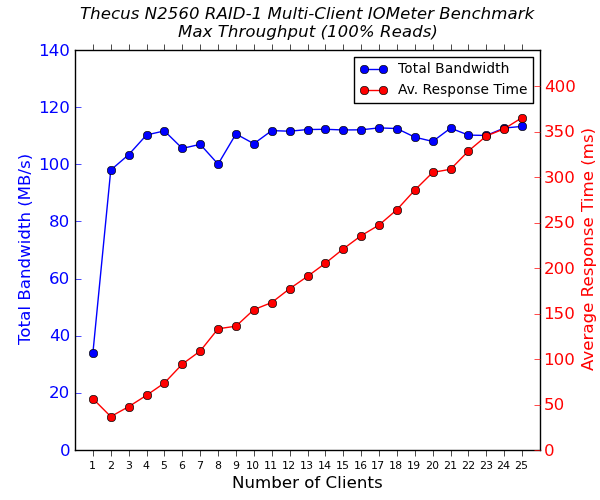
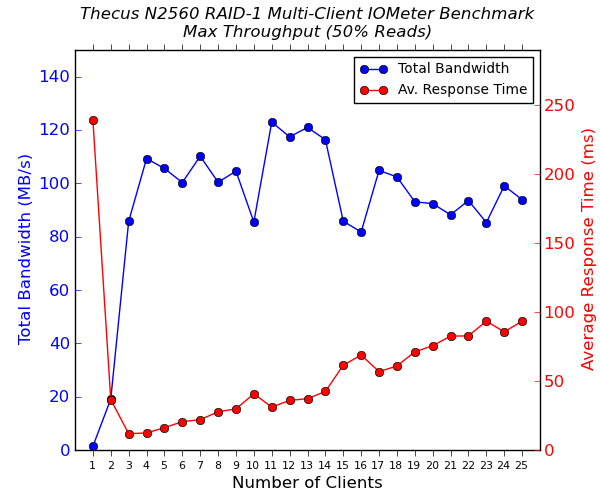
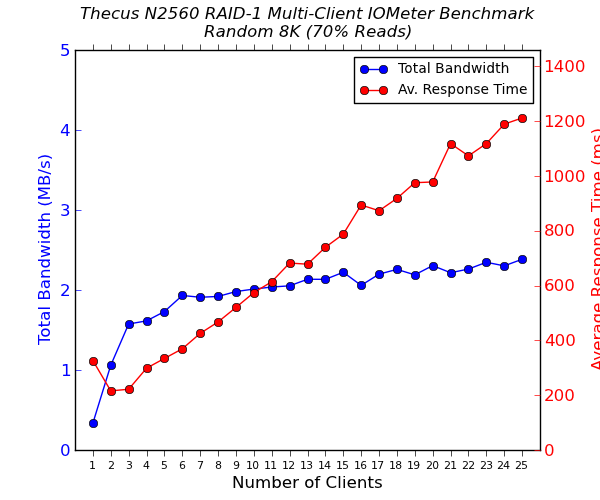
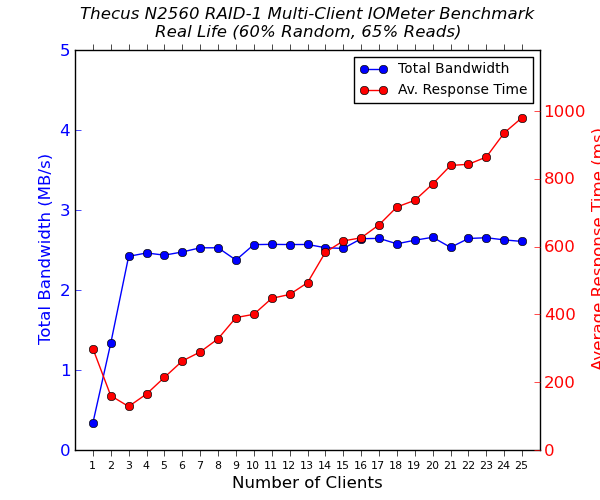
Comparing these graphs with what we obtained for the ioSafe N2 / Synology DS213, it can be inferred that the Thecus N2560 manages to maintain performance even as the number of clients connected to it keeps increasing. For the Synology DS213, we saw a dip in performance after more than 10 clients started connecting to it. The Thecus N2560 also manages to get consistently better average response times in various tests (for the same number of clients). However, it is not clear whether the average home consumer will have more than 10 clients simultaneously accessing data on the NAS. In that case, the choice may come down to non-performance aspects.










73 Comments
View All Comments
Bob Todd - Tuesday, November 26, 2013 - link
You nailed it with the appliance reference. There's a lot of people out there who know enough, or have been screwed by a lack of backups when disaster struck before, that want a simple redundant backup solution. They don't have 20TB of blu-ray rips, they just want to keep their documents/family photos/etc. safe from hardware failures. I bought a cheap 2 bay Iomega ix2 for my parents when Newegg had them on sale for $80 and it's already saved me from a data related headache. For myself I built a much more capable home server, but our needs are completely different.JeffS - Monday, November 25, 2013 - link
I have been using a 2-bay Synology NAS for years now. It draws very little power, takes up minimal space in my networking closet, and was ridiculously easy to configure. Even this older NAS supports 2 TB drives, and I'm running them in RAID 1. Just the other day, one died on me, and I was alerted by an alarm and yellow LEDs. I popped in a new drive, the RAID rebuilt, and I was good to go. When I've got 10,000 images from my cameras on a system, I do not want to tinker with it- I just want it to work. This little 2-bay box let me remove the local storage from all of the PCs in the house and put it in a place where I can easily back it up and where there's redundancy. Access is slower than on a local drive, but it's not bad over gigabit wired Ethernet.In short, I have enough other things to tinker with that I don't want to fuss with my NAS. The software is polished & convenient, and all I really need is redundancy in a small footprint, so a 2-bay unit is perfect for me.
Namisecond - Friday, December 20, 2013 - link
Might want to check your data for corruption after a drive goes south. RAID 1 doesn't offer data correction.Duodecim - Tuesday, November 26, 2013 - link
I'm very technical, and I want a 2-bay NAS or enclosure. Two reasons:I don't trust cheap non-battery backed RAID controllers, nor their rebuild procedures; RAID adds complexity with dubious benefits in a lot of end-consumer situations. You'd be better off manually sync'ing disks or creating snapshots (by means of hardlinks like rsync or Time Machine, or by means of filesystems like btrfs and zfs) and having the benefit that you can retrieve files that you accidentally deleted. Even if the RAID itself works fine, if you knock over the NAS, lightning strikes, you burn down your house or somebody runs off with all your gadgets, you better have backups somewhere else – you'd be better off with 2-bay non-RAID enclosures in different places than putting all your eggs in one basket.
The other reason is the added heat, noise, power consumption and space when running a loaded 4, 5 or even 8-bay enclosure. That's assuming your data fits in a 2-bay enclosure, of course.
Oscarcharliezulu - Wednesday, November 27, 2013 - link
You are exactly right about snapshots vs raid. When you share data with the family and especially kids, being able to restore previous versions or accidentally deleted files is the biggest benefit. Then having 2 nas boxes means if one dies due to its power supply or some other hardware (non disk) problem, you have a redundant backup. Do people really need raid 6 for their torrent files? For photos yes but really for your ripped off media? No.Namisecond - Friday, December 20, 2013 - link
Depends on what you're torrenting...For any archival purpose, RAID 6 is recommended. It really sucks when that snapshot you took turns out to be unreadable because 1 of your mirrored drives was going and spread the corruption to the other drives.easp - Tuesday, November 26, 2013 - link
1. Two bay devices are significantly cheaper, and accommodates enough storage for me now.2. Buying excess capacity now is foolish, because it will generally be cheaper when I actually need it. Moreover, I'd rather age out older drives and replace them, rather than keep them around and add to them.
3. Having two two-bay devices provides me with more redundancy than one four bay device. I generally duplicated data between devices, rather than between drives in the same device.
4. I'm not convinced that the upsides of RAID5/6 make up for the downsides, especially since I don't need 4-5 drives worth of raw storage.
CSMR - Wednesday, November 27, 2013 - link
For a lot of people 1 bay is sufficient. Most people's family data will fit on 4TB. Having a NAS is just as advantageous in this situation.Just because you are technically savvy does not mean you have more than 4TB of data you need to put on your network.
puremind - Saturday, November 30, 2013 - link
Against 4+ bays:-Bulkiness
-Cost of upgrading hard drives
Increased cooling need
With 2 bay:
You ALREADY get access to all of the features that NAS has to offeI, i.e. DNS, Home Media Streaming Server, Android Apps to access media and files from your smartphone, detached storage that your laptop can access wirelessly from you sleeping room to stream HD content to your home cinema.
That's why 2bay is so popular. Consumers don't buy NAS systems for redundancy but for the features and convenienceof accessing all bulky media wirelessly. It is a kind of storage extension for laptops that can't afford that kind of space and bulkiness.
Silma - Sunday, December 1, 2013 - link
I agree absolutely it is an enigma for me.A non-tech person would be better buying a LaCie (or whatever) 2-mirrored drive solution which he would plug in directly.
Tech people would be better off with much more hard drive.
I did study the market 3 years ago and came to the conclusion that I would have to build it myself to stay within budget.
So I bought 6 1.5 TB hard drives (best GB/$ at the time) plus an LSI raid controller, and configured the drives in RAID 6 for maximum availability. This setup was less expensive than an enclosure with 0 drive and a much less powerful much slower raid system.
Today I don't think anything has changed. What's more I don't see any enclosure specialized in 2.5 (e.g. SSD) but I didn't research much.